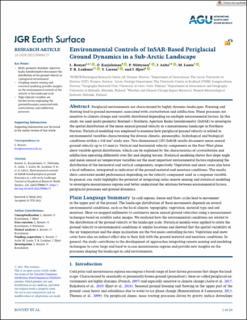| dc.contributor.author | Rouyet, Line | |
| dc.contributor.author | Karjalainen, Olli | |
| dc.contributor.author | Niittynen, P. | |
| dc.contributor.author | Aalto, Juha | |
| dc.contributor.author | Luoto, Miska | |
| dc.contributor.author | Lauknes, Tom Rune | |
| dc.contributor.author | Larsen, Yngvar | |
| dc.contributor.author | Hjort, J. | |
| dc.date.accessioned | 2021-08-25T08:03:41Z | |
| dc.date.available | 2021-08-25T08:03:41Z | |
| dc.date.created | 2021-08-11T11:28:56Z | |
| dc.date.issued | 2021 | |
| dc.identifier.citation | Journal of Geophysical Research (JGR): Earth Surface. 2021, 126 (7), . | en_US |
| dc.identifier.issn | 2169-9003 | |
| dc.identifier.uri | https://hdl.handle.net/11250/2771096 | |
| dc.description.abstract | Periglacial environments are characterized by highly dynamic landscapes. Freezing and thawing lead to ground movement, associated with cryoturbation and solifluction. These processes are sensitive to climate change and variably distributed depending on multiple environmental factors. In this study, we used multi-geometry Sentinel-1 Synthetic Aperture Radar Interferometry (InSAR) to investigate the spatial distribution of the mean annual ground velocity in a mountainous landscape in Northern Norway. Statistical modeling was employed to examine how periglacial ground velocity is related to environmental variables characterizing the diverse climatic, geomorphic, hydrological and biological conditions within a 148 km2 study area. Two-dimensional (2D) InSAR results document mean annual ground velocity up to 15 mm/yr. Vertical and horizontal velocity components in the East–West plane show variable spatial distribution, which can be explained by the characteristics of cryoturbation and solifluction operating differently over flat and sloping terrain. Statistical modeling shows that slope angle and mean annual air temperature variables are the most important environmental factors explaining the distribution of the horizontal and vertical components, respectively. Vegetation and snow cover also have a local influence, interpreted as indicators of the ground material and moisture conditions. The results show contrasted model performance depending on the velocity component used as a response variable. In general, our study highlights the potential of integrating radar remote sensing and statistical modeling to investigate mountainous regions and better understand the relations between environmental factors, periglacial processes and ground dynamics | |
| dc.language.iso | eng | en_US |
| dc.rights | CC BY-NC-ND 4.0 | * |
| dc.rights.uri | https://creativecommons.org/licenses/by-nc-nd/4.0/ | * |
| dc.title | Environmental Controls of InSAR-Based Periglacial Ground Dynamics in a Sub-Arctic Landscape | en_US |
| dc.type | Peer reviewed | en_US |
| dc.type | Journal article | en_US |
| dc.rights.holder | © 2021, Author(s) | |
| dc.description.version | publishedVersion | |
| cristin.ispublished | true | |
| cristin.fulltext | original | |
| cristin.qualitycode | 2 | |
| dc.identifier.doi | 10.1029/2021JF006175 | |
| dc.identifier.cristin | 1925282 | |
| dc.source.journal | Journal of Geophysical Research (JGR): Earth Surface | en_US |
| dc.source.volume | 126 | en_US |
| dc.source.issue | 7 | en_US |
| dc.source.pagenumber | 24 | en_US |
| dc.relation.project | Norges forskningsråd: 263005 | |

